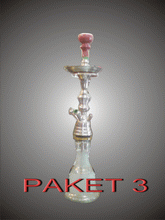Often there is confusion with terminology. While in the west, the device itself is referred to as a Hookah, and the tobacco/molasses is referred to as the Shisha. However, in the Arab world, the device itself is called a shisha (in reference to its glass base) and the tobacco is called moassel. Depending on locality, hookahs or Shishas may be referred to by many names, Arabic Language use it as Shisha or Nargeela or Argeela and they use it throughout the whole of the Arab World. Turkish people use it as Narghilè but pronounced "Argilah" is the name most commonly used in Turkey, Azerbaijan, Lebanon, Syria and Palestine. Narghile derives from the Persian word nārghile, meaning coconut, which in turn is from the Sanskrit word nārikela (नारिकेला), suggesting that early hookahs were hewn from coconut shells.
In Albania, Bosnia, Croatia the hookah is called "Lula" or "Lulava" in Romani, meaning "pipe," the word "shishe" refers to the actual bottle piece.
Shisha (شيشة), from the the Farsi word shīshe (شیشه), meaning glass, is the common term for the hookah in Egypt and the Arab countries of the Persian Gulf (including Kuwait, Iraq, Bahrain, Qatar, Oman, UAE, and Saudi Arabia), Palestine and in Morocco, Tunisia, Somalia and Yemen.
In Iran, hookah is called غلیون "Ghalyoon". In Uzbekistan, hookah is called "Chillim". In India and Pakistan the name most similar to the English hookah is used: huqqa (हुक्का /حقہ).
The commonness of the Indian word "hookah" in English is a result of the British Raj, the British dominion of India (1858–1947), when large numbers of expatriate Britons first sampled the water-pipe. William Hickey, shortly after arriving in Kolkata, India, in 1775, wrote in his Memoirs:
"The most highly-dressed and splendid hookah was prepared for me. I tried it, but did not like it. As after several trials I still found it disagreeable, I with much gravity requested to know whether it was indispensably necessary that I should become a smoker, which was answered with equal gravity, "Undoubtedly it is, for you might as well be out of the world as out of the fashion. Here everybody uses a hookah, and it is impossible to get on without" [... I] have frequently heard men declare they would much rather be deprived of their dinner than their hookah."





